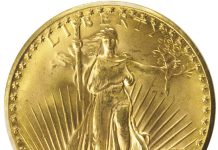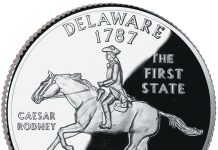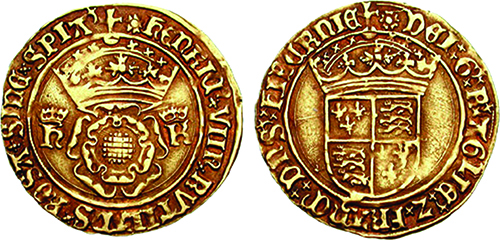
Editor’s Note: This is part of the ‘Money of British Monarchs’ series of articles
By R.W. Julian
Of all the British rulers over the last thousand years, the one perhaps best known is Henry VIII, who was married six times but had unorthodox methods of divorce. He was both justly admired and widely hated even in his own time, and his fame has come down to us in many ways.
His birth, on June 28, 1491, was not especially auspicious, as he was the second son of Henry VII and Queen Elizabeth of York. His older brother was Arthur, Prince of Wales and direct heir to the throne. In Arthur’s case, the future seemed bright and in November 1501 he married Katherine of Aragon, a Spanish princess renowned for her beauty.
Henry VII’s Early Rise
In those days, however, good health was often fleeting, even for young people, and so it was for Arthur. He died suddenly in early April 1502 and, at the tender age of 10, Prince Henry became the Prince of Wales. This meant that his schooling was ratcheted up several degrees, as a future king was expected to be well educated so that he might rule in the best interests of the nation.
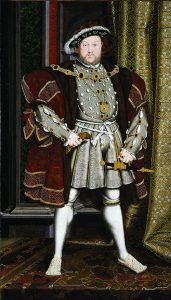
Henry VII was something of a miser and had managed to accumulate a considerable private fortune, even to the point of being able to loan money to Italian bankers, the international moneymen of their time. Usually, it was the other way around, with most royal houses being in debt to the moneylenders.
Although Henry VII was good at accumulating wealth, his health was not all that robust after 1507—and in April 1509 he died, full of honors and to the genuine sorrow of his subjects, who had been at peace for most of his reign. The new king, Henry VIII, was made from an entirely different mold.
To the surprise of many, one of the new king’s first acts, only a few weeks after his accession to the crown, was to marry Arthur’s widow—Katherine of Aragon. This was a genuine love match, at least for the first few years, and in 1516 their only child, Mary, was born to great rejoicing. Now that he was a father, Henry felt sure that Katherine soon would produce a male heir, one of the essential facts of life if the ruling house was to continue in unbroken fashion.
Coinage Under Henry VIII
In the meantime, there was the question of gold and silver coinage for the realm. Gold was handled only by great merchants and the ruling class, but silver was the domain of the common people and was widely used in the marketplace.
Although we think of a typical new ruler demanding completely new designs as soon as possible after becoming king, such was not the case in England from 1509 through 1526. In fact, the old designs of Henry VII were kept in place on the larger silver coins, including even the sharp-faced profile portrait of the late king. The designs were well thought out, but it was Henry VII who originally had decided upon them, not Henry VIII.
While the silver denominations of that period are easily understood by the modern numismatist, those for the gold are not. For the first 17 years of the new king’s reign, there were only four gold denominations: the sovereign (20 shillings, or one pound), the ryal (10 shillings), the angel (six shillings, eight pence) and the half angel (three shillings, four pence).
Despite the odd values of the angel and half angel, there were practical commercial reasons for these two coins—even they do not appear so to modern eyes. But in 1526, when the designs were changed to reflect the wishes of Henry VIII, the gold coins’ values began to fluctuate and must have been confusing even in those days. The sovereign, for example, became 22 shillings, six pence, but in 1544 reverted back to 20 shillings.
Exploration of ‘First Coinage’
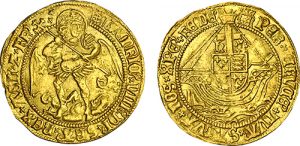
The silver of 1509-1526, called the “First Coinage” by modern numismatists, is rather straightforward, at least compared to the gold. There were five denominations: groat (four pence), half groat, pence, half pence and farthing (quarter pence).
The groat was an impressive silver coin, slightly larger than the modern U.S. quarter dollar. The larger silver coins generally were struck at London, though some provincial mints did issue the smaller pieces on a regular basis.
The farthing, oddly enough, was struck from half pence dies, and the public was expected to distinguish between the two coins strictly by weight. This curious arrangement was corrected in 1526 by using a distinctive design for the smaller- value coin. The whole matter is perhaps irrelevant to modern numismatists, as very few farthings were struck during the reign of Henry VIII.
If the farthing was a rare denomination, what did the public use in its place? Actually, merchants and others produced lead tokens, which were used in lieu of the smallest coins. The government generally looked the other way, as it was not easy for the mints to strike such small coins and still make a profit.
While the First Coinage was underway, Henry began to dabble in foreign affairs, which proved very expensive both for him and for the nation. A fun-loving ruler, Henry lost little time in spending the accumulated private wealth of Henry VII and constantly badgered Parliament for fresh funds to be put at his ready disposal.
Impacts of Invasion on Coinage
In 1512, at the urging of Queen Katherine, Henry sent English troops across the channel to invade France on the side of Spain. This was an expensive proposition and seemed to devour money at an alarming rate.
By luck, the English army generally was successful, though England did not gain all that much for its troubles.
There is a numismatic reminder of this struggle because a temporary mint was established at Tournai, striking mostly groats. Tournai reverted to France in 1518, however.
At about the same time that Tournai was lost to Henry, he also began to lose interest in Queen Katherine. Eventually, a few years and several affairs later, his roving eye noticed Anne Boleyn, a striking beauty involved with the court because of her aristocratic family.
Because he wished to marry Anne, Henry instructed his chief minister, Thomas Wolsey, to arrange a divorce—no easy matter in those days, as it required special dispensation from the pope in Rome. Henry, however, had gotten some favorable notice from Rome earlier when he had attacked Martin Luther and the Reformation.
At that time, Henry had been granted the special title of “Defender of the Faith,” an honor which later showed up on British coinage during the time of George III.
Divorce and Denominations
Pope Clement VII sent a special legate to England in 1527 to hear the matter, but the
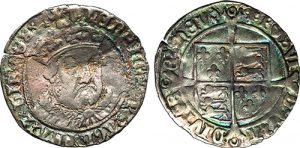
papal envoy abruptly returned to Rome in 1528 without making a decision. This enraged Henry, who instructed Wolsey to push for the divorce—but the latter fell from power in 1529 and was replaced by the energetic Sir Thomas More, better known in modern times as the “Man for All Seasons.” The king was aided in this endeavor by Thomas Cromwell, an equally adept member of Henry’s inner circle.
In the early 1530s, Henry gained serious attention from Rome by threatening to create an independent English church, beholden only to the king. Clement VII thought Henry was bluffing, but this was a fatal mistake and Henry duly carried out the threat.
The new English church promptly granted the divorce, and Henry married Anne Boleyn in January 1533. In September of that year, she gave birth to a child, named Elizabeth. Henry now had two children, but both were girls.
In 1526, when the divorce was but a gleam in Henry’s eye, the coinage system was overhauled. Too much gold was going across the channel, so the values were increased by about 10 percent, the value of the sovereign going from 20 shillings to 22 shillings, six pence, as noted previously.
At the same time, several new denominations were created, such as the crown of the rose (four shillings, six pence) and the crown of the double rose (five shillings). In all, there were eight gold denominations, and one has to wonder how useful the system was.
Crown Design References Wives
The crown of the double rose and a similar half crown are especially interesting to modern numismatists. Henry put the initials of three wives on these gold coins: Katherine of Aragon (K), Anne Boleyn (A) and Jane Seymour (I). It is possible that the fifth wife (Katherine Howard) shared the letter K with Katherine of Aragon; numismatists are divided on this point.
The profile portrait of Henry VIII was added to the groat and half groat in 1526 and showed a smooth-faced ruler. In 1527, Henry grew a beard, but the portrait was not updated until 1544, when the Third Coinage (1544-47) commenced.
From 1526 to 1544, a considerable quantity of silver coins from the Second Coinage was struck, and specimens can be obtained with relative ease and at reasonable cost. The farthing, however, continued to be made in small quantities and a decent specimen will cost well over a thousand dollars.
The groats of the Second Coinage, with one exception, were made at London. The exception was struck at the ecclesiastical mint at York, which was under the control of Henry’s chief minister, Cardinal Thomas Wolsey.
The latter fell from power in 1529, however, one of the charges against him being that he had struck groats without royal permission and had even put his cardinal’s hat and initials (TW) on the reverse. Wolsey died on the way to his trial, which almost certainly would have ended with the headsman’s ax.
At the beginning of Henry’s reign, there were several provincial mints, including some controlled by the church—but by 1542, most of these had been forced out of existence, with the coinage now concentrated primarily at London and under direct royal control. The non-London pieces most commonly seen today are from Canterbury and York, both relatively prolific coin producers during that era.
During the mid-1530s, the break with Rome and Clement VII was made complete and Henry proceeded to loot the monasteries and convents of their wealth and lands. These were either kept by the king or parceled out to his loyal supporters.
Looting Leads to More
The silver and gold thus obtained fueled Henry’s foreign wars, but there never was enough money for such purposes. By 1540, the old religious establishment had been destroyed and replaced by the Church of England.
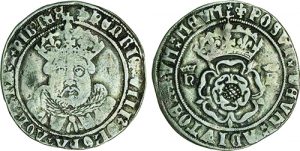
At the palace, meanwhile, all was not going well. Anne Boleyn, the second wife, had produced a baby girl, but after that she suffered a series of miscarriages. A frustrated Henry VIII prepared trumped-up charges of adultery against Anne, and she went to the executioner’s block in May 1536.
The king’s ever-roving eye already had settled on Jane Seymour. The new queen delivered a healthy baby boy, Edward, in October 1537 but died in childbirth, an all-too-common occurrence in those days.
After a lengthy search, English diplomats promoted Anne of Cleves as the fourth wife and sent a painting by Hans Holbein to impress Henry. He liked what he saw and the nuptials were announced.
When Anne came to England, however, Henry was less than pleased and made some unfavorable remarks about the accuracy of the painting. He did reluctantly marry Anne of Cleves, but soon persuaded her that a real divorce was better than the ax. She got the message and quietly faded from the scene.
The next wife (in 1541) was Katherine Howard, but here the adultery might have been real and she, too, went to the block, in February 1542. The last wife, Katherine Parr, outlived Henry, and their relationship is generally thought to have been a cordial one.
Funding Wars by Debasing Currency
By 1543, Henry once more was desperate for funds to pay for his foreign wars, especially the one with France. Parliament was increasingly unresponsive to his seemingly endless demands for higher taxes, so Henry turned to debasing the currency for a quick profit.
In 1544, the law was changed and the silver coinage became the main target of his debasement efforts. Over the next three years, its fineness would fall from more than 90 percent to only 25 percent, creating a quick influx of funds but at the same time presenting problems for the future.
Because of the debasement, Henry introduced a denomination not seen for several decades: the shilling (12 pence)—or, as it was called in those days, the “testoon.” The testoon was roughly the size of the modern U.S. half dollar and an impressive coin when struck in high-quality silver.
Unfortunately, as the massive debasement gathered momentum, the quality of the silver coinage took a nosedive. The shilling had a facing portrait of Henry, now with a beard, but the fineness was so low that any kind of wear exposed the copper. For this reason, Henry soon became known as “Old Copper Nose,” probably not one of his favorite expressions.
Britons quickly realized the extent of the debasement and the fact that they were being cheated out of their rightful funds by a greedy king. Among the comments that made the rounds: “These testons looke redde … they blush for shame.”
By late 1546, Henry VIII was running out of places to raise more funds. The debasement could go no further and Parliament was increasingly restive. Perhaps it was just as well that the king died in January 1547 at the age of 55; matters would have gotten only worse for him after that time.
Henry was succeeded by his son Edward VI, who continued to issue the debased coinage for a short time but then began the painful process of undoing the damage. Edward died in 1553 and was followed by his older sister, Mary, but she died in 1558.
The next ruler was Elizabeth I, the daughter of Anne Boleyn and one of the greatest monarchs to occupy the English throne.


